GoPro Hero vs. SJCAM SJ4000
This page is a work-in-progress. I only put it online because I keep finding myself talking about the cameras on Reddit and would find it useful to point people to the information I've compiled so far. As such, there are advantages and disadvantages of each camera that are not yet listed.Image Sensor
GoPro Hero
The GoPro Hero has a 2592x1944 image sensor.
Video in 1280x720 seems to be recorded from a 2560x1440 area centered within the sensor. This is quite good in terms of quality as there are exactly four image sensor pixels for each video pixel and so the math is cleaner. I haven't yet investigated how 1920x1080 is gathered from the image sensor, but I suspect it is gathered from the same 2560x1440 area. Video is recorded with a horizontal field of view of 120°.
The only video mode that captures from the full image sensor, the "superview" mode, is positively retarded and universally disliked, as it greatly distorts the image by taking a 4:3 image and turning it into a 16:9 video. I can only guess that the reason a proper 4:3 video resolution was omitted was to provide incentive to purchase the Hero 3 instead, which has an identical image sensor resolution, but comes with the features of being able to record 1280x960 video and being able to configure the time lapse interval.
Photos are taken from the full image sensor and stored at the same resolution.
Video in 1280x720 seems to be recorded from a 2560x1440 area centered within the sensor. This is quite good in terms of quality as there are exactly four image sensor pixels for each video pixel and so the math is cleaner. I haven't yet investigated how 1920x1080 is gathered from the image sensor, but I suspect it is gathered from the same 2560x1440 area. Video is recorded with a horizontal field of view of 120°.
The only video mode that captures from the full image sensor, the "superview" mode, is positively retarded and universally disliked, as it greatly distorts the image by taking a 4:3 image and turning it into a 16:9 video. I can only guess that the reason a proper 4:3 video resolution was omitted was to provide incentive to purchase the Hero 3 instead, which has an identical image sensor resolution, but comes with the features of being able to record 1280x960 video and being able to configure the time lapse interval.
Photos are taken from the full image sensor and stored at the same resolution.
SJCAM SJ4000
The SJCAM SJ4000's manufacturer doesn't tell us the resolution of the image sensor, other than to claim on the box that it is 12 megapixels. It clearly isn't. In my own tests, I've come to the conclusion that the image sensor is 2304x1536.
Video in 720p seems to come from a 2272x1266 region of the image sensor, which isn't quite centered within the sensor, but which isn't exactly uncentered either. I have no clue why this should be the case. I spent so long trying to figure out this nonsense that I forgot all about doing the same for 1080p recording. Anyway, this has the effect that the horizontal field of view is only about 110° despite the lens otherwise being quite similar to the Hero's lens.
The SJ4000 also offers 640x480 recording. I suspect this is taken from the already clipped region of the image sensor used for 16:9 recording, as the field of view isn't nearly as wide.
Photos seem to be taken from the full image sensor, in as much as any of them can considering that none of the available resolutions match the 3:2 aspect ratio of the image sensor. All photo resolutions other than 1920x1080 are 4:3 aspect ratios. As such, it isn't possible to take a photo that captures the full view of the image sensor.
Video in 720p seems to come from a 2272x1266 region of the image sensor, which isn't quite centered within the sensor, but which isn't exactly uncentered either. I have no clue why this should be the case. I spent so long trying to figure out this nonsense that I forgot all about doing the same for 1080p recording. Anyway, this has the effect that the horizontal field of view is only about 110° despite the lens otherwise being quite similar to the Hero's lens.
The SJ4000 also offers 640x480 recording. I suspect this is taken from the already clipped region of the image sensor used for 16:9 recording, as the field of view isn't nearly as wide.
Photos seem to be taken from the full image sensor, in as much as any of them can considering that none of the available resolutions match the 3:2 aspect ratio of the image sensor. All photo resolutions other than 1920x1080 are 4:3 aspect ratios. As such, it isn't possible to take a photo that captures the full view of the image sensor.
White Balance
GoPro Hero
I haven't yet tested the Hero's white balance in depth, largely because it seems to always do well.
SJCAM SJ4000
The SJ4000's white balance is often incorrect.
Indoors it often chooses a very yellow color. This occurs in both fluorescent and incandescent lighting, but seemingly not in low natural lighting. Outdoors it tends to be too blue, requiring the use of the manual settings of "daylight" or "cloudy." There is no manual white balance setting appropriate for indoor use, they all look yellow.
The problem seems to be a bug in the firmware. The camera seems to get stuck in poor white balance mode, and I can often get it unstuck by placing some blue denim fabric very close to the lens for a few seconds, and after removing it the white balance will be much improved, though it often still seems a bit off. Other times there is something in the scene that as soon as it is seen by the camera causes it to turn yellow again, and once it is in yellow mode again, it will not change back even when turned to a view it was previously OK with, unless the blue denim trick is used again.
There are two images for "CFL lighting" and "incandescent lighting," the ones with better color being obtained simply by powering the camera on in the room with the "daylight" bulbs rather than powering it on in the room with the type of lighting being tested. The "the actual colors" image was taken with a different camera.
Indoors it often chooses a very yellow color. This occurs in both fluorescent and incandescent lighting, but seemingly not in low natural lighting. Outdoors it tends to be too blue, requiring the use of the manual settings of "daylight" or "cloudy." There is no manual white balance setting appropriate for indoor use, they all look yellow.
The problem seems to be a bug in the firmware. The camera seems to get stuck in poor white balance mode, and I can often get it unstuck by placing some blue denim fabric very close to the lens for a few seconds, and after removing it the white balance will be much improved, though it often still seems a bit off. Other times there is something in the scene that as soon as it is seen by the camera causes it to turn yellow again, and once it is in yellow mode again, it will not change back even when turned to a view it was previously OK with, unless the blue denim trick is used again.
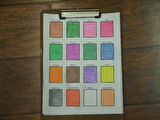 the actual colors |
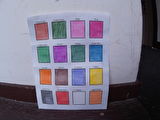 in natural light |
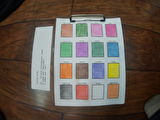 "daylight" bulbs |
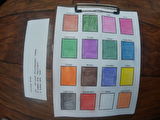 "daylight" bulbs |
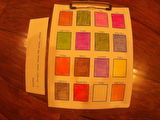 CFL lighting |
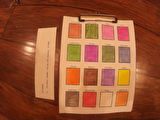 CFL lighting |
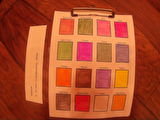 incandescent lighting |
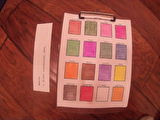 incandescent lighting |
There are two images for "CFL lighting" and "incandescent lighting," the ones with better color being obtained simply by powering the camera on in the room with the "daylight" bulbs rather than powering it on in the room with the type of lighting being tested. The "the actual colors" image was taken with a different camera.
Video Quality
GoPro Hero
720p is quite good, due to there being 4 image sensor pixels for each output pixel, such that an interpolation filter almost isn't required. (You still need a filter due to how image sensor pixels work, but it has a much simpler task to accomplish and so it works better.)
1080p leaves a lot to be desired, not only because of fewer pixels, but also because of a poor interpolation filter that seems to merely choose the nearest pixel.
SuperView is is positively retarded and universally disliked, as it greatly distorts the image by taking a 4:3 image and turning it into a 16:9 video. I'm almost certain that when I first bought the camera I was able to simply convert it back to a 4:3 aspect ratio and get useful video from it. However, a firmware update seems to have changed the way it works. It now employs an algorithm that attempts to make it less distorted, and in doing so, renders it completely useless, since it is no longer possible to simply convert it to a 4:3 aspect ratio as it will still be distorted.
1080p leaves a lot to be desired, not only because of fewer pixels, but also because of a poor interpolation filter that seems to merely choose the nearest pixel.
SuperView is is positively retarded and universally disliked, as it greatly distorts the image by taking a 4:3 image and turning it into a 16:9 video. I'm almost certain that when I first bought the camera I was able to simply convert it back to a 4:3 aspect ratio and get useful video from it. However, a firmware update seems to have changed the way it works. It now employs an algorithm that attempts to make it less distorted, and in doing so, renders it completely useless, since it is no longer possible to simply convert it to a 4:3 aspect ratio as it will still be distorted.
SJCAM SJ4000
720p is quite good. While there isn't the wonderful 4:1 ratio of image sensor to pixels that the Hero has, it seems to employ an excellent interpolation filter such that the image clarity is virtually identical to the Hero, if not slightly better.
1080p is also quite good. Unlike the Hero, the SJ4000 uses a good interpolation filter, and so the 1080p quality is clearly superior to that of the Hero despite the smaller size of the image sensor.
1080p is also quite good. Unlike the Hero, the SJ4000 uses a good interpolation filter, and so the 1080p quality is clearly superior to that of the Hero despite the smaller size of the image sensor.
Comparison of Video Stills
Here's an image showing both cameras in both 1080p (top) and 720p (bottom) modes recording a resolution chart from the same distance. Note that the SJ4000's images appear larger due to its smaller field of view.
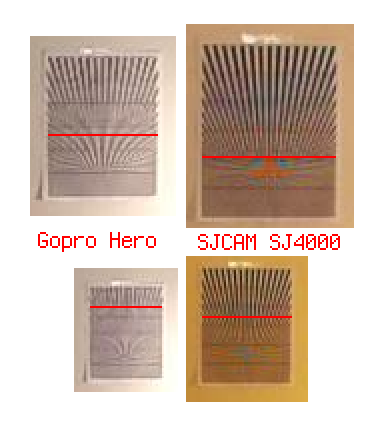
To help interpret the results, I drew a red line at what should be the transition between distinct lines and solid color, given each camera's optical properties and image sensor resolution, and assuming ideal processing of the raw data from the image sensor by the camera's hardware and software. Basically the red line represents optimal clarity for each camera's lens and image sensor in each resolution.
The top-right image, showing the SJ4000's 1080p mode, is nearly ideal in terms of what we'd hope to see. The lines above the red line are distinct, and everything below the red line is blurred to the point of being a solid gray. Ideally the orange and teal below the red line wouldn't be there, as they are an effect of the line spacing matching the spacing of the image sensor pixels.
The bottom-right image, showing the SJ4000's 720p mode, has one additional defect, in that lines are visible below the red line. This is not additional detail, but rather, it is aliasing, due to there being no low-pass filter applied during interpolation to remove frequencies from the image data which cannot exist in the more limited output resolution.
The bottom-left image, showing the Hero's 720p mode, looks nearly ideal. I probably should have photographed a second chart for it since it's at the limit of being able to test it with that particular chart, but I think it's safe to say that the only fault is the small amount of aliasing visible 1/3 from the bottom of the page.
The top-left image, showing the Hero's 1080p mode, demonstrates just how poor the Hero's 1080p mode is. The blurriness above the red line is the result of the poor interpolation filter, rendering the 1080p mode only about half of the improvement over the 720p mode that it should be. There's also a lot of aliasing below the red line, which occurs in a bizzare pattern, likely due to the simplistic point filter modifying the frequencies in unusual ways.
In summary, the Hero's 1080p mode seems rather defective, but the other modes of both cameras seem to work just fine, with the SJ4000 having a slight lead in terms of image clarity, though one must not forget the obvious defect of poor white balance.

To help interpret the results, I drew a red line at what should be the transition between distinct lines and solid color, given each camera's optical properties and image sensor resolution, and assuming ideal processing of the raw data from the image sensor by the camera's hardware and software. Basically the red line represents optimal clarity for each camera's lens and image sensor in each resolution.
The top-right image, showing the SJ4000's 1080p mode, is nearly ideal in terms of what we'd hope to see. The lines above the red line are distinct, and everything below the red line is blurred to the point of being a solid gray. Ideally the orange and teal below the red line wouldn't be there, as they are an effect of the line spacing matching the spacing of the image sensor pixels.
The bottom-right image, showing the SJ4000's 720p mode, has one additional defect, in that lines are visible below the red line. This is not additional detail, but rather, it is aliasing, due to there being no low-pass filter applied during interpolation to remove frequencies from the image data which cannot exist in the more limited output resolution.
The bottom-left image, showing the Hero's 720p mode, looks nearly ideal. I probably should have photographed a second chart for it since it's at the limit of being able to test it with that particular chart, but I think it's safe to say that the only fault is the small amount of aliasing visible 1/3 from the bottom of the page.
The top-left image, showing the Hero's 1080p mode, demonstrates just how poor the Hero's 1080p mode is. The blurriness above the red line is the result of the poor interpolation filter, rendering the 1080p mode only about half of the improvement over the 720p mode that it should be. There's also a lot of aliasing below the red line, which occurs in a bizzare pattern, likely due to the simplistic point filter modifying the frequencies in unusual ways.
In summary, the Hero's 1080p mode seems rather defective, but the other modes of both cameras seem to work just fine, with the SJ4000 having a slight lead in terms of image clarity, though one must not forget the obvious defect of poor white balance.
Audio Quality
GoPro Hero
It seems fine. I can hear people talk, it doesn't sound poor, exactly what I would expect.
SJCAM SJ4000
The sound seems quiet, frequency-limited, and includes a bizzare metalic cringworthy ringing in the higher frequencies. I suspect it has no low-pass filter employed, and so higher frequencies are aliasing to lower frequencies.
Photo Quality
GoPro Hero
Very good quality, but also very blurry in low light as the camera is unwilling to use a higher ISO setting. You cannot take a clear photo indoors without a tripod.
It seems to employ a sharpness enhancement to the photos, as evident by transistions between light and dark objects including unnatural variations in brightness near the transition. I'll have to include a photo eventually to demonstrate.
My only complaint is the sharpness algorithm being non-optional. Such things should really be left to the user, since such enhancements cannot be undone. ...and you might want to undo the effect. It tends to make images look as if they've been processed by the "oil painting" effect of a graphics program if you look closely at the pixels, giving photos a cartoonish appearance.
I'd complain more about the sharpness effect if it weren't that generally you expect to get a high quality photo of 1/2 of a camera's image sensor resolution anyway, and yet the Hero spits out photos that look great in its native resolution, and so it is hard to complain too much about it. However, whatever it is doing to achieve that level of quality could surely be accomplished later on a computer, and so it really should be optional.
It seems to employ a sharpness enhancement to the photos, as evident by transistions between light and dark objects including unnatural variations in brightness near the transition. I'll have to include a photo eventually to demonstrate.
My only complaint is the sharpness algorithm being non-optional. Such things should really be left to the user, since such enhancements cannot be undone. ...and you might want to undo the effect. It tends to make images look as if they've been processed by the "oil painting" effect of a graphics program if you look closely at the pixels, giving photos a cartoonish appearance.
I'd complain more about the sharpness effect if it weren't that generally you expect to get a high quality photo of 1/2 of a camera's image sensor resolution anyway, and yet the Hero spits out photos that look great in its native resolution, and so it is hard to complain too much about it. However, whatever it is doing to achieve that level of quality could surely be accomplished later on a computer, and so it really should be optional.
SJCAM SJ4000
Reasonably good photos. Originally I thought they were only half as good as the Hero, but in recent days I've begun wondering why as some direct comparisons seem to look nearly identical in quality. Unfortunately it's the middle of winter and so it's going to be a while before I encounter a sunny day and an attractive scene such that I can really see what each camera is capable of.
In low light, it takes much less blurry photos than the Hero, but as one would expect, employs a higher ISO setting to do so, and as such the photos will look grainy. However, because the ISO is configurable, you may have the option of choosing a lower setting and using a tripod for a clearer photo. Strangely I still haven't tried this to see how the outcome compares to the Hero. In any event, if you'll be taking photos without a tripod indoors, you'll definately want the SJ4000 for that task.
No sharpness algorithm seems to be involved.
In low light, it takes much less blurry photos than the Hero, but as one would expect, employs a higher ISO setting to do so, and as such the photos will look grainy. However, because the ISO is configurable, you may have the option of choosing a lower setting and using a tripod for a clearer photo. Strangely I still haven't tried this to see how the outcome compares to the Hero. In any event, if you'll be taking photos without a tripod indoors, you'll definately want the SJ4000 for that task.
No sharpness algorithm seems to be involved.
Comparison of Photos
I photographed a resolution chart from identical distances with each camera. Note that the SJ4000, despite having a smaller image sensor, also has a smaller field of view, and so the two images turned out nearly the same size.

Unfortunately I didn't draw red lines to indicate optimal resolution, since at this point I was mostly just trying to determine what the SJ4000's image sensor's resolution actually was, since the manufacturer lies about it.
It's hard to pick a winner here. On the one hand, the size of the paper on the SJ4000 side is slightly larger, and so we should see slightly more detail, and so perhaps an additional line of bars should be visible. However, the opposite is true, as one fewer line is distinct on the SJ4000 side. The Hero is also very good at eliminating the orange and teal color effects that result from the bars aligning with the image sensor's color pixels. The only other thing I note is that each row of bars is more distinct on the SJ4000's image, but then it is showing the paper larger due to its field of view, and so this may not be relevant.
The SJ4000 also has the ability to take photos in resolutions higher than its image sensor's resolution, and so I created a comparison of its highest resolution to the Hero's only resolution.
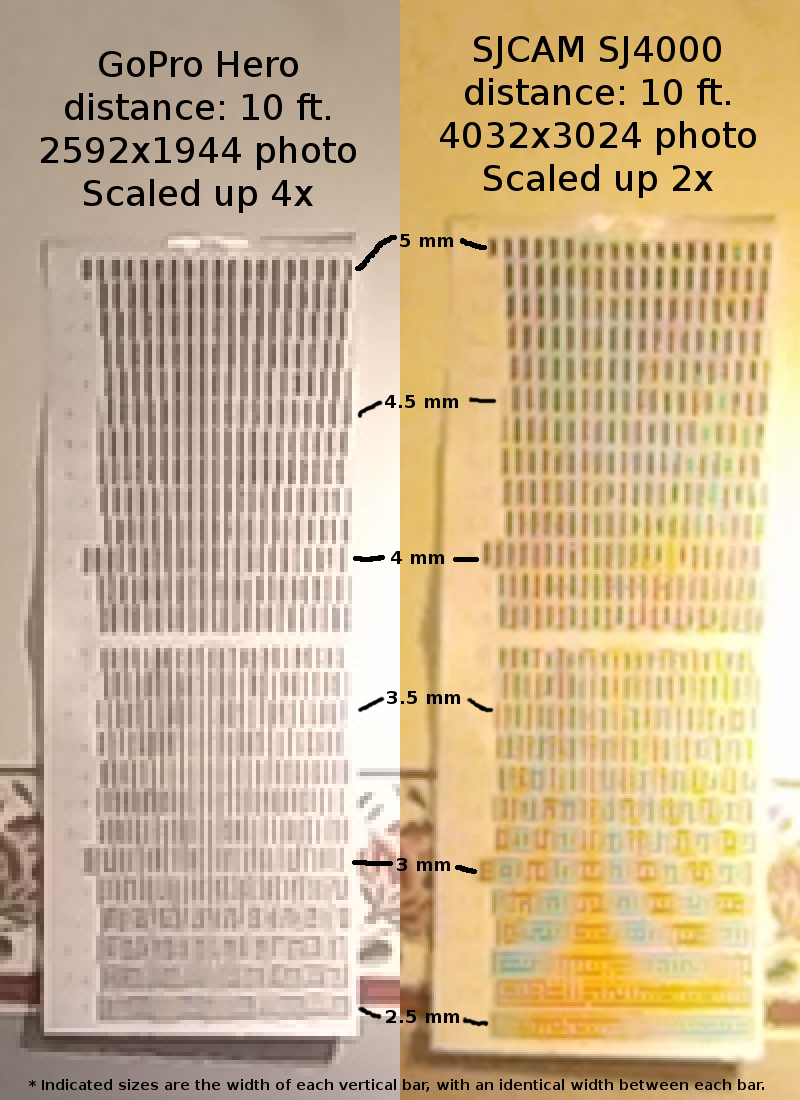
Again, I can't really pick a winner. It's like the Hero is doing some things better (in particular it avoids the orange and teal effect well) but then it screws up elsewhere, perhaps a result of that sharpness enhancement it does, or perhaps just a side-effect of the effort to avoid the orange and teal effect.
It's worth noting that the SJ4000's performace isn't nearly as good as it looks. Look at the 4 mm line for example, where one of the black lines is reduced to a yellowish brown smudge almost like someone took an eraser to it. Further up there are several bars that turned into teal smudges. Still, the fact that it manages to resolve so many of the bars correctly is impressive, even if that detail is interpolated.
It's quite possible I just need to make some better charts. The ones with continuous lines, like I used for the video tests, make the result much more obvious than the separate rows of different spacings used here.

Unfortunately I didn't draw red lines to indicate optimal resolution, since at this point I was mostly just trying to determine what the SJ4000's image sensor's resolution actually was, since the manufacturer lies about it.
It's hard to pick a winner here. On the one hand, the size of the paper on the SJ4000 side is slightly larger, and so we should see slightly more detail, and so perhaps an additional line of bars should be visible. However, the opposite is true, as one fewer line is distinct on the SJ4000 side. The Hero is also very good at eliminating the orange and teal color effects that result from the bars aligning with the image sensor's color pixels. The only other thing I note is that each row of bars is more distinct on the SJ4000's image, but then it is showing the paper larger due to its field of view, and so this may not be relevant.
The SJ4000 also has the ability to take photos in resolutions higher than its image sensor's resolution, and so I created a comparison of its highest resolution to the Hero's only resolution.

Again, I can't really pick a winner. It's like the Hero is doing some things better (in particular it avoids the orange and teal effect well) but then it screws up elsewhere, perhaps a result of that sharpness enhancement it does, or perhaps just a side-effect of the effort to avoid the orange and teal effect.
It's worth noting that the SJ4000's performace isn't nearly as good as it looks. Look at the 4 mm line for example, where one of the black lines is reduced to a yellowish brown smudge almost like someone took an eraser to it. Further up there are several bars that turned into teal smudges. Still, the fact that it manages to resolve so many of the bars correctly is impressive, even if that detail is interpolated.
It's quite possible I just need to make some better charts. The ones with continuous lines, like I used for the video tests, make the result much more obvious than the separate rows of different spacings used here.